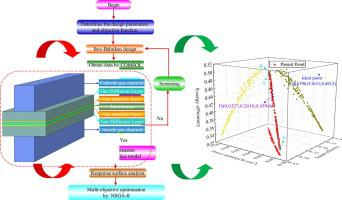Energy Conversion and Management ( IF 10.4 ) Pub Date : 2023-01-19 , DOI: 10.1016/j.enconman.2023.116691 Zhijie Chen , Wei Zuo , Kun Zhou , Qingqing Li , Yuhan Huang , Jiaqiang E

|
This study optimized the performance of a proton exchange membrane fuel cell by combining the response surface methodology and non-dominated ranking genetic algorithm. Firstly, the design variables are determined, including operating pressure (p), operating temperature (T), Anode stoichiometry ratio (λa), thickness of the proton exchange membrane (Hmem) and gas diffusion layer (GDL) porosity (εGDL). The objective functions are also identified, including power density (P), system efficiency (η) and exergy efficiency. Then, the Box-Behnken design is employed to arrange the numerical investigations. Analysis of variance is used to verify the appropriateness and reliability of the constructed regression models. Response surface analysis is used to show the interaction between each pair of design parameters. Finally, the Pareto optimal frontier is obtained by non-dominated ranking genetic algorithm II and the regression models constructed by response surface methodology. The Pareto optimal solution offers a power density of 0.6327 W·cm−2, a system efficiency of 26.16% and an exergy efficiency of 43.94 %, which is 13.18 %, 7.06 % and 20.29 % better than the initial direct current channel, respectively. The corresponding design variables is p = 2.6498 atm, T = 341.621 K, λa = 1.1808, Hmem = 0.0577 mm and εGDL = 0.4908. This work provides a new multi-objective optimization method for designing more efficient proton exchange membrane fuel cells.
中文翻译:

RSM 和 NSGA-II 对质子交换膜燃料电池的多目标优化
本研究结合响应面法和非支配排序遗传算法优化了质子交换膜燃料电池的性能。首先,确定设计变量,包括工作压力(p)、工作温度(T)、阳极化学计量比(λ a)、质子交换膜厚度(H mem)和气体扩散层(GDL)孔隙率(ε GDL ). 还确定了目标函数,包括功率密度 ( P )、系统效率 ( η) 和火用效率。然后,采用 Box-Behnken 设计来安排数值研究。方差分析用于验证所构建回归模型的适用性和可靠性。响应面分析用于显示每对设计参数之间的相互作用。最后,通过非支配排序遗传算法Ⅱ和响应面法构建的回归模型得到帕累托最优边界。Pareto最优解的功率密度为0.6327 W·cm -2,系统效率为26.16%,火用效率为43.94%,分别比初始直流通道提高13.18%、7.06%和20.29%。相应的设计变量为p = 2.6498 atm, T = 341.621 K,λ a = 1.1808,H mem = 0.0577 mm 和ε GDL = 0.4908。这项工作为设计更高效的质子交换膜燃料电池提供了一种新的多目标优化方法。



























 京公网安备 11010802027423号
京公网安备 11010802027423号